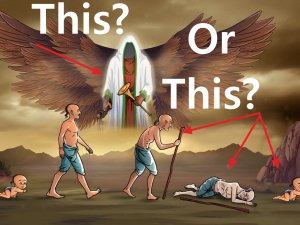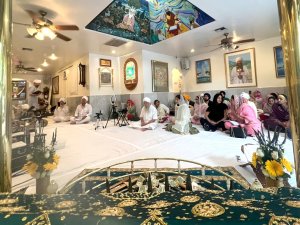What is the first thing that comes to mind when you hear the word ‘kaam’? Probably lust. Often times ‘kaam’ is meant to describe the state of a person who is lost in maya , addicted to sex or obsessed with sexual thoughts. In Gurbani any fixation is discouraged and the Guru describes five main fixations that we tend to have. Kaam is often spoken first when referring to these five vices: kaam, krodh, lobh, moh, ahankaar. This lusty kaam is often coupled with anger, both being fiery maladies. One can feed the fire, but it will not be calmed, it will only grow bigger. One is not to make the mistake of trying to satisfy all their sexual desires. In more western terms one might say, “When the devil wants to dance with you, you better say never. Because a dance with the devil might last you forever.” In Gurbani it is said,
hio paavak eedhan nahee dhraapai bin har kahaa aghay “The flame is not satisfied by more fuel; how can one be satisfied without the Lord?” Ang 672
In these days of over exposure of virtual sexual content and increasingly unrealistic presentations of sexuality and pleasure, especially the younger generation will do well to remember these teachings.
So is Kaam bad? In this case there is more to the story than that. It is like asking if gravity is good or bad. For someone falling off a cliff, gravity will definitely be bad. For a hawk, gravity is the law which allows for flight. Gravity is neither good nor bad, it is a force that must be respected. The Guru certainly teaches us respectful fear of the forces at work in our bodies. Many times we are kept at attention to not be subjected to the five vices. But not being subjected to and denying the existence of are two different things. To deny the force of one's own sexuality is futile, so long as we have bodies we will have senses. In order to deal with Kaam Gurbani does not instruct us to deny it, rather to replace it. We are instructed to fixate ourselves on Naam. The Guru truly does teach us about balance and unattachment. The Guru is also clear that such a difficult balance cannot be successfully struck without the blessing of the True Guru.
bin satguru kinai n paee param gate
“Without the True Guru it is impossible to attain the supreme state.”Ang 1348
Kaam further sticks out among the other “vices” because of the versatility in which the word in used. Kaam has another meaning: 'Desire' or 'work'. In this sense the word simply depends on the context in which it is used.
kaam kari je thakur bhava “I do that work which pleases my Master.” ang 212
In this example kaam is translated as ‘work’. There are many such instances in Gurbani.
Now let us see it in another variation that is hardly ever mentioned. There is another use of kaam in the sexual context but instead of being a vice it is a blessing. There are four cardinal boons. Ancient traditions held that if a Guru was a true holy man, he could grant his followers certain blessings. Indeed endless are the stories of miraculous birth of children or wealth being imparted to a pious student of any one of various holy personalities throughout history. But only a True Guru can grant the FOUR CARDINAL BOONS. In Gurbani this is called ‘Char Padaarath’. These four blessings are sustained blessings and fulfill every aspect of the disciple, body, mind and spirit. They become a completely fulfilled person here and hereafter.
The four boons are: Dharam, Arth, Kaam and Mokh. Namely:
1. The path of righteousness
2. Physical wealth
3. Sexuality (sometimes translated as ‘sexual success’)
4. Liberation from reincarnation
While some paths may focus on liberation, rarely is one blessed with both wealth and liberation. While certain blessed few are granted the grace to live with righteousness, even fewer will be blessed with both righteousness and sexual success.The person gifted with the four boons, who walks the path of a perfectly righteous one, has material wealth, sexual success and is living liberated from the cycle of birth and death... is truly a rare disciple.
The concept of char padaarath, the four boons, is central to the teachings of the Guru. In fact Guru Nanak says that we have incarnated into human form just to obtain these four boons.
chaar padaarath lai jag aya
“The mortal has come to the world to obtain the four boons.”
Ang 1026
Only the greatest spiritual guide can grant a person such powerful and rounded blessings. Here is an example of the four cardinal boons used in Gurbani almost as a pet name to describe how great the Guru is.
dharm, arth ar kaam, mokh mukat padaarath naath
“The Lord is the Master of (the four boons of) Righteousness, Wealth, Sexual Success and Liberation.”
Whether ‘sexual success’ is the best translation for this cardinal boon the scholars can debate. What is not debatable is that kaam can not only mean ‘lust’, it has more implications than that. It is both a vice and a blessing. Like gravity, it is a force. We must not take this force. Neither are we to deny it if it comes to us in a goodly manner by the blessing of the Guru.
This is a wide subject with many implications which applies to every person, married, single, celibate and everything between. Only the Guru can be our guide for us to know if we are taking rather than receiving kaam. We can be very thankful that we have the living Siri Guru so we will never be without clarity of where we stand.
The path laid before us by the Guru’s is vast, sublime and indescribable. Our understanding of it will always reach its limit only to be expanded again. Our living of it has not reached its zenith until the Guru deems us as complete. We do not deem ourselves to be liberated, we are Sikhs, we are always learning. In the mean time, we place our heads at the Guru’s feet and do our best to live full lives, with victory on every level. Oh Guru, who is powerful to give the four boons, dharam, arth, kaam and mokh carry us through as your very own children.
With Thy Grace.
References
On a cursory look here are Ang’s in Siri Guru Granth Sahib ji where ‘chaar padaarath’ is mentioned:
108, 154, 295, 617, 799, 856, 1026, 1085, 1106, 1227, 1345
Here are a few examples in where Dharm, Arth, Kaam, Mokh are specifically mentioned:
ang 805, 816, 1320
Dharm, Arth, Kaam, Mokh used as praise of the True Guru:
927






